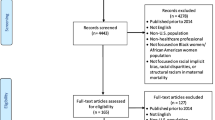Abstract
“Risky Business” considers hospital childbirth and the production of the concept of risk in obstetrics. Risk is a defining concept of medicalized childbirth. Approaching obstetrical risk with a goal of challenging its hold on practices demonstrates how risk itself is produced and maintained in particular institutional contexts. The goal here is to imagine new ways of understanding and assessing obstetrical risk, as part of an overall strategy of challenging technocratic approaches to childbirth and mothering. Surveying feminist approaches to childbirth, the essay discusses how the mother’s health profile affects both medical education and the construction of childbirth as “risky business.”
Similar content being viewed by others
References
See Judith Walzer Leavitt, Brought to Bed: Childbearing in America, 1750-1950
Robbie Davis-Floyd, “The Role of Obstetrical Rituals in the Resolution of Cultural Anomaly,” Social Science and Medicine 31 (1990): 175-89, and Birth as an American Rite of Passage (Berkeley, CA: University of California Press, 1994).
Leavitt, Brought to Bed, 5; see also 171-95.
Rosalind Petchesky, “Fetal Images: The Power of Visual Culture in the Politics of Reproduction,” Feminist Studies, 13 (1987): 263-92; reprinted in The Gender Sexuality Reader, ed. Roger N. Lancaster and Micaela di Leonardo (New York: Routledge, 1997), 134-50.
Robbie Davis-Floyd, “The Technocratic Body: American Childbirth as Cultural Expression,” Social Science and Medicine 38 (1994): 1125-40.
Jessica Mitford, The American Way of Birth (New York: Penguin—Dutton, 1992).
Helena Michie and Naomi Cahn, Confinements: Fertility and Infertility in Contemporary Culture (New Brunswick, NJ: Rutgers University Press, 1997), 45-67.
Because of the increasing social influence of risk as a concept, the parameters of any investigation of risk and obstetrical practice are quite large. This essay represents an initial conceptualization of how to think through the construction of risk in obstetrics and does not thoroughly address the social pressures on physicians to overcome all of the potential difficulties of childbirth to produce perfect babies. My starting point is that risk is a concept produced through specific practices; in obstetrics, its meanings are linked to social expectations and the technologies that often represent, and incite, those expectations.
See Leavitt, Brought to Bed.
Davis-Floyd, Birth as an American Rite of Passage, 177-84.
Elizabeth Cartwright and Jan Thomas, “Constructing Risk: Maternity Care, Law, and Malpractice,” in Birth by Design: Pregnancy, Maternity Care, and Midwifery in North America and Europe, ed. Raymond Devries, et al. (New York: Routledge, 2001), 218.
Leavitt, Brought to Bed; Robbie Davis-Floyd, “The Role of Obstetrical Rituals in the Resolution of Cultural Anomaly,” in Birth as an American Rite of Passage, and “The Technocratic Body”; Mitford, American Way; Charlotte Borst, Catching Babies: The Professionalization of Childbirth, 1870-1920 (Cambridge, MA: Harvard University Press, 1995); and Barbara Katz Rothman, In Labor: Women and Power in the Birthplace (New York: W. W. Norton, 1982) and “Spoiling the Pregnancy: Prenatal Diagnosis in the Netherlands,” in Birth by Design,180-198.
Davis-Floyd, “The Technocratic Body,” 1125.
See Elizabeth Cartwright, “The Logic of Heartbeats: Electronic Fetal Monitoring and Biomedically Constructed Birth,” in Cyborg Babies: From Techno-sex to Techno-tots,” eds. Robbie Davis-Floyd and Joseph Dumit (New York: Routledge, 1998), 240-54, for an interesting discussion of practice in medicine.
All evidence presented here concerning EFM, its efficacy and relation to outcomes, was originally presented in the lecture, unless otherwise noted.
Cartwright, “Logic of Heartbeats,” 241.
Electronic fetal monitors are not always strapped in place; they can be held to the mother’s abdomen by hand. According to Cartwright, the “logic” of the monitor is to constrain the mother’s ability to change position and to free up labor attendants to care for numerous mothers at the same time (Ibid., 246).
See also Michael Benson, Obstetrical Pearls (Philadelphia: F. A Davis, 1994), quoted in Cartwright and Thomas, “Constructing Risk,” 223; American College of Obstetrics and Gynecology, “Fetal Heart Rate Patterns: Monitoring, Interpretation, and Management,” Technical Bulletin 207 (July 1995), cited in Cartwright, “Logic of Heartbeats,” 244; and Cartwright, Ibid., 250.
Wendy Savage, “Caesarean Section: Who Chooses—The Woman or Her Doctor?” in Ethical Issues in Maternal-Fetal Medicine, ed. Donna L. Dickenson (Cambridge: Cambridge University Press, 2002), 264, 267. Because most c-sections are performed as a result of perceived danger to the infant if born vaginally or if the pregnancy were to continue longer, it is more difficult to assess the relative danger of surgical birth on infants. However, it is well known that infants born surgically often experience respiratory distress, as their lungs have not been massaged by the process of labor.
Cartwright and Thomas, “Constructing Risk,” 224.
See also Ibid., 222.
Cartwright, “Logic of Heartbeats,” 246.
Leavitt, Brought to Bed, 189-95; Cartwright, “Logic of Heartbeats,” 247; see also Davis-Floyd, “The Technocratic Body,” 1137.
For a discussion of the ethics of elective cesarean section, see Savage, “Caesarian Section.”
Kaye Lowman, The LLLove Story (Franklin Park, IL: La Leche League Internation, 1978), 88.
Leavitt, Brought to Bed, 42-43.
Raymond DeVries, et al., “What (and Why) Do Women Want? The Desires of Women and the Design of Maternity Care,” in Birth by Design,259.
Davis-Floyd, “The Technocratic Body,” 1126-32; see also DeVries, et al. for a discussion of how what women want in maternity care is affected by what they are offered by medical professionals.
Elizabeth Cartwright has made a similar point in “The Logic of Heartbeats,” 246-47.
Ann Oakley, The Captured Womb: A History of the Medical Care of Pregnant Women (Oxford: Basil Blackwell, 1984), 1
The question for Leavitt concerns who manages the birth situation and thus dominates its meanings for women: “Childbirth is more than a biological event in women’s lives. It is a vital component in the social definition of womanhood. Historically, women’s physiological ability to bear children and men’s inability to do so have contributed to defining the places each held in the social order. The sexual differentiation between women and men fostered a cultural division of labor based on these biological distinctions, a division that allocated the domestic sphere to women and the public sphere to men” (3). Thus, the very beginning of Brought to Bed establishes sexual difference as grounded in biology and the cultural meanings of childbirth to be attached to this biological foundation. Leavitt later writes: “My historical interests in the interactions between medicine and society developed into a specific interest in the history of childbirth as a direct result of my personal confinement experiences. During the hours of labor and delivery I understood and accepted a bond with biological womanhood...” (5).
Oakley, The Captured Womb, 2; emphasis in original.
Apparently regardless of the effect on actual outcomes; see Davis-Floyd, Birth as an American Rite of Passage, 177-84.
See Savage, “Caesarian Section,” 266-68, for a discussion of these points.
Michael Bérubé states the risk as 1 in 225 for having a Down syndrome baby and 1 in 200 for having a miscarriage caused by the amniocentesis for a woman aged 36. Life as We Know It: A Father, A Family, and an Exceptional Child (New York: Random House—Vintage, 1996), 6-7.
In making this point I am neither arguing against amniocentesis nor against elective abortion in the case of a positive Down’s diagnosis (or in any other case).
See Bérubé, Life, for an excellent discussion of trisomy 21 (17-24) and for a discussion of the issue of abortion as a response to detection of chromosomal anomalies (40-94). For a good, brief history of the development of amniocentesis as a technology, see Rayna Rapp, Testing Women, Testing the Fetus: The Social Impact of Amniocentesis in America (New York: Routledge, 2000), 23-32.
Bérubé, Life, 76.
Leavitt, Brought to Bed, 174, 194; see also pp. 170-95 for a general discussion of the impact on women of moving birth from home to hospital.
Bernice L. Hausman, Mother’s Milk: Breastfeeding Controversies in American Culture (New York: Routledge, 2003), 222.
Davis-Floyd, “The Technocratic Body,” 1137.
The simple answer to this last question may be that ordinary American mothers got their wishes answered when their husbands were allowed access to the delivery room and hospitals responded to the threat of the home birth movement by providing birthing centers and other more homey birth options. For example, see Diane Eyer, Mother-Infant Bonding: A Scientific Fiction (New Haven: Yale University Press, 1992), and Kerreen M. Reiger, Our Bodies, Our Babies: The Forgotten Women’s Movement (Melbourne, Australia: University of Melbourne Press, 2001), esp. 62-83 and 212-37, for a discussion of the childbirth education movement in Australia.
According to the Centers for Disease Control, “One in every four or five pregnant women carries GBS [Group B Streptococcus] in the rectum or vagina. A fetus may come in contact with GBS before or during birth.” Because GBS “is the most common cause of sepsis... and meningitis... in newborns,” the CDC recommends that women who test positive for GBS late in pregnancy be offered prophylactic antibiotics “at the time of labor or membrane rupture.” Centers for Disease Control, “Group B Streptococcal Disease (GBS). Division of Bacterial and Mycotic Diseases,” http://www.cdc.gov/ncidod/dbmd/diseaseinfo/groupbstrep_g.htm. (Accessed 24 December 2002.) However, there are risks involved in using prophylactic antibiotics in the large population of women who test positive for GBS but are not symptomatic at the time of delivery; and “have a relatively low risk of delivering an infant with GBS disease.” Midwife Archives, Gentlebirth.org, “Group B Strep (GBS),” http://www.gentlebirth.org/archives/gbs.html. (Accessed 31 August 2003.) For a discussion of the widespread of antibiotics and risk of fungal infection in nursing infants, see Kathleen L. Hoover, “Yeast Infections of the Nipples and Breasts,” http://www.medela.com/NewFiles/thrush.html. (Accessed 1 September 2003.)
Davis-Floyd‘s “The Technocratic Body” provides an especially provocative analysis along these lines.
DeVries et al., “What (and Why),” demonstrate how difficult raising these questions can be, let alone finding answers to them.
See, for example, Thomas H. Strong, Jr., M.D., Expecting Trouble: The Myth of Prenatal Care in America (New York: New York University Press, 2000), 1-32, for an example of a physician-authored monograph that attempts this kind of multi-layered analysis.
Author information
Authors and Affiliations
Corresponding author
Rights and permissions
About this article
Cite this article
Hausman, B.L. Risky Business: Framing Childbirth in Hospital Settings. J Med Humanit 26, 23–38 (2005). https://doi.org/10.1007/s10912-005-1050-3
Issue Date:
DOI: https://doi.org/10.1007/s10912-005-1050-3




